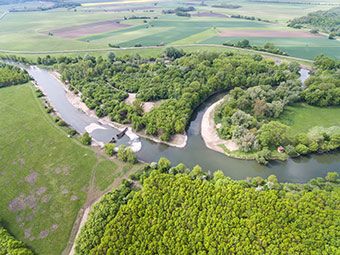To ensure the Thaya River basin’s uniqueness is protected for generations to come, stakeholders from both sides of the Czech Republic and Austrian border are better coordinating water management and conservation efforts under this EU-funded project.
- 04 October 2019
Every metre we return to the river will ensure more water returns to the countryside and stays there for a long time. In doing so, we are fighting the drought that has been plaguing South Moravia in recent years.
The Thaya River, located along the Czech Republic – Austria cross-border region, is surrounded by the largest and most ecologically valuable floodplains in all of the Central Europe. The river basin is renowned for its reservoirs, national parks, and environmental initiatives. But in the 1970s and 1980s, both countries began straightening the river’s natural flow. As a result, the river’s length was reduced by almost 3.2 km.
The main objective of this project is to return the Thaya River back to its natural course and introduce a sustainable management plan. To accomplish this, the project created cross-border mechanisms for monitoring the river’s watercourse, promoting sustainable fish stocks, and improving the morphology of the river’s flow. In addition, the project added the ‘green’ infrastructure needed to support, for example, fish reproduction and animal migration.
Back to its natural flow
The river’s current course serves as the border between the Czech Republic and Austria. Returning it to its original meandering route would necessarily involve a change in national borders. Thus, the need for cross-border cooperation.
The solution was reconnecting the oxbows – the meanders that were cut off when the river was straightened – to the main watercourse. These were scattered along both sides of the border, and some straddled the border. Doing so has extended the river’s length by more than 1 km. Through this connection, the Thaya will naturally regain its original length and the typical character of its floodplain.
Other initiatives of this project included the creation of a new habitat for natural fish reproduction within Thaya National Park, implementing cross-border regulations for fish management, and strategies for removing logs and other debris from the river.
Everyone benefits
Thanks to this project’s work, national park administrators, water management authorities, citizens, and visitors on both sides of the river will benefit from a sustainable and naturally beautiful river valley.
Total investment and EU funding
Total investment for the project “DYJE 2020 - THAYA 2020” is EUR 1 756 833, with the EU’s European Regional Development Fund contributing EUR 1 493 308 through the “Interreg V-A - Austria-Czech Republic” Operational Programme for the 2014-2020 programming period. The investment falls under the priority “Environment and resources”.

